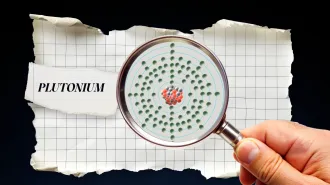View the video
A shattered windshield has a story to tell. The key to hearing it is counting the cracks.

The number of cracks that emerge in a plate of glass or Plexiglas relates to the speed of the object that broke it, researchers demonstrate April 26 in Physical Review Letters. This simple relationship could prove useful for forensic scientists, archaeologists and even astronomers.
Over the past century, most research into cracks has focused on parameters that determine whether a material remains intact when struck.
Nicolas Vandenberghe and his colleagues at Aix-Marseille University in France decided to try something different: They wanted to push glass and other materials past their breaking points and study the resulting fractures. They wondered if they could connect the patterns of cracks to the properties of the impact that created them, something no one had done before, Vandenberghe says.
So he and his team set up a shooting gallery. The targets were small squares of glass and Plexiglas between 0.15 millimeters and 3 millimeters thick. The researchers’ weapon was a gun filled with pressurized air that fired 4-millimeter-wide steel pellets, about the size of BB’s, at speeds ranging up to 432 kilometers per hour.
Knowing that cracks emerge within a matter of microseconds of impact, Vandenberghe employed a high-speed camera that shoots 30,000 frames per second to capture the instant of collision. His team broke more than 100 plates and then counted the cracks that extended outward in a star-shaped pattern from the point of impact.
The photographic evidence revealed a clear connection: After taking into account the type of material and its thickness, the number of cracks doubled for every fourfold increase in the pellet’s speed. For example, a 70-kph pellet caused an average of four cracks in 1-millimeter-thick Plexiglas plates, while a 280-kph one made eight.
The study’s approach is clever, says Alan Zehnder, a mechanical engineer at Cornell University. But he points out that most impacts do not lead to such orderly, star-shaped crack patterns. He also notes that Vandenberghe’s materials were on a smaller scale than most everyday examples: The plates in the experiment are much thinner than a typical windowpane, he says, and the steel pellets were significantly smaller than rocks that shatter windshields.
Still, the study could yield useful understanding of star-shaped cracks. Vandenberghe wonders whether forensic scientists could derive new information from broken windows at a crime scene. His work could also help archaeologists reconstruct cracked ceramic pottery or astronomers decipher the collisions that produced fractures on the surface of a planet or moon.
Pellets burrow through millimeter-thick Plexiglas plates. Shown is an 80-kilometer-per-hour pellet that creates four cracks, followed by a 204-kph projectile that makes eight.
Credit: N. Vandenberghe/Aix-Marseille Univ.







